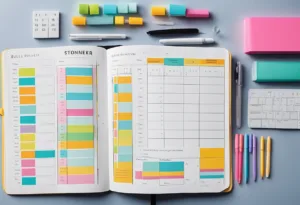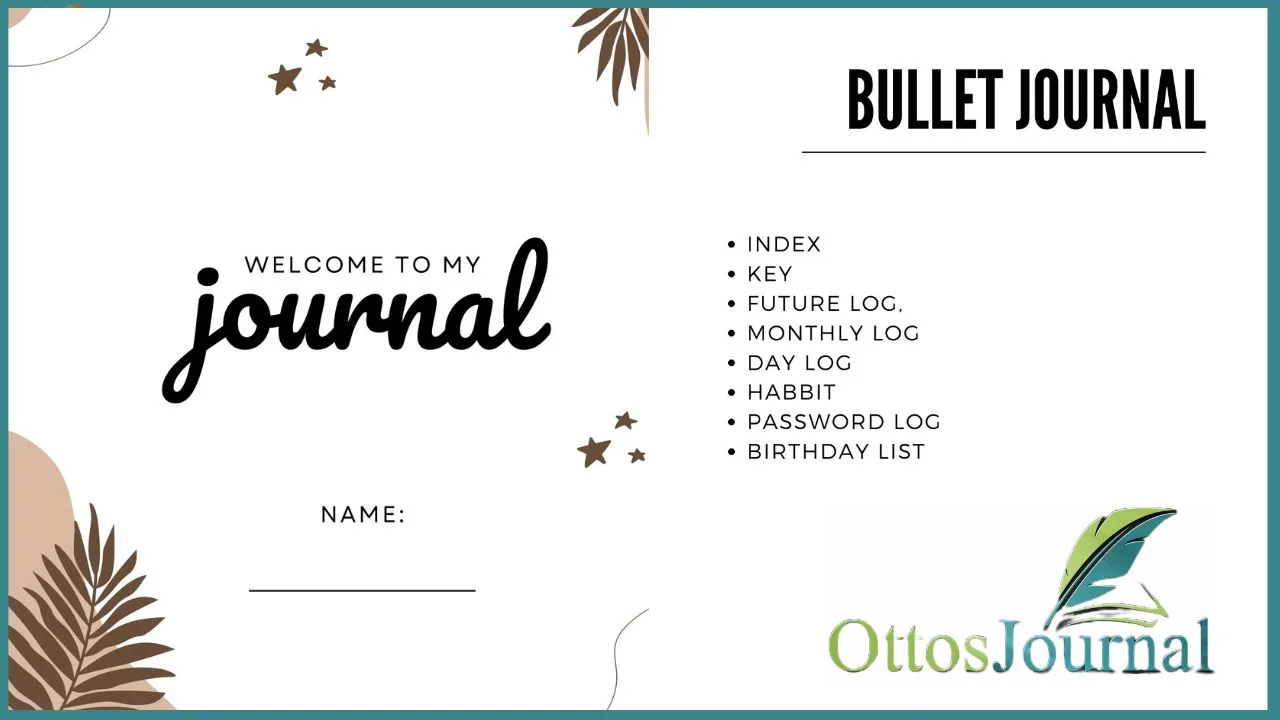Bullet journaling has become an increasingly popular method of organizing one’s life, and it’s no surprise that people are using it to manage their finances as well. With a bullet journal budget tracker, individuals can keep track of their expenses, monitor their progress towards financial goals, and gain a better understanding of their overall financial situation. In this blog post, I will share with you 45 bullet journal budget tracker ideas to help you keep track of your spending.
A bullet journal budget tracker can be customized to fit an individual’s unique needs and preferences. Some people prefer to keep it simple with a basic monthly budget tracker, while others may want to include detailed expense logs and savings goals. The beauty of bullet journaling is that it allows for flexibility and creativity, so individuals can design their budget tracker in a way that works best for them.
Whether someone is just starting out on their financial journey or looking to gain more control over their spending habits, a bullet journal budget tracker can be a useful tool in achieving financial success. With a little bit of creativity and dedication, anyone can create a budget tracker that helps them stay on track towards their financial goals.
Setting Up Your Bullet Journal Budget Tracker
Creating a bullet journal budget tracker can be a great way to keep track of your finances and stay on top of your expenses. In this section, we’ll go over some tips for setting up your bullet journal budget tracker.
Choosing the Right Journal and Supplies
When it comes to choosing the right journal and supplies for your bullet journal budget tracker, there are a few things to keep in mind. First, you’ll want to choose a journal that works well with bullet journaling. Many people prefer dotted journals, as they allow for more flexibility in terms of layout and design.
In addition to a journal, you’ll also need some pens and other supplies. Many people prefer to use pens with a fine tip, as they allow for more precise writing and drawing. You may also want to invest in some stickers or other decorative elements to add some personality to your budget tracker.
Bullet Journal Budget Tracker Basics
Before you start designing your budget tracker layout, it’s important to understand the basics of how a bullet journal budget tracker works. A budget tracker is essentially a way to keep track of your income and expenses over a certain period of time. You can choose to track your spending on a weekly, bi-weekly, monthly, or yearly basis, depending on your needs.
To set up your budget tracker, you’ll want to create a list of categories for your income and expenses. This might include things like rent, groceries, entertainment, and so on. You’ll also want to set a budget for each category, based on your income and expenses.
Designing Your Budget Tracker Layout
Once you have a basic understanding of how your budget tracker will work, you can start designing your layout. There are many different ways to design a bullet journal budget tracker, so feel free to get creative and experiment with different layouts and designs.
Some popular budget tracker layouts include tables, graphs, and charts. You may also want to include some decorative elements, such as stickers or washi tape, to add some personality to your budget tracker.
Setting up a bullet journal budget tracker can be a great way to take control of your finances and stay on top of your expenses. With a little bit of planning and creativity, you can create a budget tracker that works well for your needs and helps you achieve your financial goals.
35 Bullet Journal Budget Tracker Ideas
Bullet journaling can be an effective way to manage your finances. Here are 35 bullet journal budget tracker ideas and brief explanations on how to implement them:
- Monthly Budget Spread: Create a two-page spread with income on one side and expenses on the other, categorizing each expense.
- Expense Tracker: Log every expense as it occurs, categorizing and totaling them at the end of the month.
- Savings Goals Tracker: Draw a visual representation of your savings goals and color in as you make progress.
- Bill Payment Checklist: List all monthly bills with checkboxes to mark off when each is paid.
- Debt Payoff Tracker: Create a page for each debt and track your progress as you pay it down.
- Income Tracker: Keep a log of all your income sources and the amount you receive from each.
- Subscription Tracker: Note down all subscriptions and membership fees, along with renewal dates.
- Weekly Spending Summary: Break down your expenses by week to spot spending habits.
- No-Spend Challenge Tracker: Mark off days on a calendar where you successfully avoid spending.
- Yearly Financial Overview: Create a spread with a high-level view of your finances for the year.
- Financial Goals Page: Write down your short-term and long-term financial goals.
- Daily Spending Log: Keep a daily tally of expenses to monitor your daily spending habits.
- Holiday Budget Planner: Set a budget for gifts, food, and activities for the holiday season.
- Tax Deductions Tracker: Throughout the year, keep a log of potential tax deductions.
- Wish List Page: Keep a list of items you want to save for, which can help curb impulse spending.
- Investment Tracker: Monitor your investments and their performance.
- Financial Review Spread: At the end of each month, review what went well and what could be improved.
- Coupon and Discount Tracker: Keep track of coupons and discounts to use before they expire.
- Grocery Spending Tracker: Monitor your spending on groceries and find ways to save.
- Entertainment Expenses: Keep tabs on how much you’re spending on entertainment.
- Utilities Tracker: Record your monthly utility bills to notice trends and seek ways to reduce them.
- Car Maintenance Log: Keep track of car-related expenses and regular maintenance.
- Gift Spending Log: Record money spent on gifts to stay within budget.
- Emergency Fund Tracker: Visualize your progress towards building an emergency fund.
- Quarterly Finance Summary: Every three months, summarize your financial status and progress.
- Cash Envelope Tracker: If you use cash envelopes for budgeting, track your allocations and spending.
- Charitable Donations Tracker: Record your charitable contributions for personal records and tax purposes.
- Financial Habit Tracker: Monitor and develop good financial habits, like reviewing statements or saving.
- Insurance Premiums Tracker: Keep track of when insurance premiums are due and how much they cost.
- Digital Spending Tracker: Monitor what you spend on digital purchases like apps and online subscriptions.
- Home Improvement Tracker: Plan and track your spending on home improvement projects.
- Retirement Savings Tracker: Keep an eye on your progress towards retirement savings.
- Education Expenses: Track tuition fees, books, and other education-related expenses.
- Travel Budget Planner: Plan and save for travel, tracking expenses against your budget.
- Healthcare Expenses: Log medical expenses, including insurance co-pays and out-of-pocket costs.
Implementing these bullet journal budget tracker ideas involves setting aside time to regularly update your trackers and review your financial progress. It’s about finding a system that works for you and helps you achieve your financial goals.
Managing Finances with Bullet Journal Spreads

Bullet journaling is a popular method of organizing and tracking various aspects of life, including finances. By creating spreads tailored to one’s financial goals and needs, individuals can gain a better understanding of their spending habits and work towards achieving financial stability. Here are some essential spreads to help manage finances using bullet journaling.
Monthly Budget Overview
One of the most crucial spreads in a bullet journal is a monthly budget overview. This spread allows individuals to set financial goals and track their progress throughout the month. It’s essential to include all sources of income and expenses, including bills, groceries, entertainment, and other miscellaneous items.
A table or a chart is an effective way to organize this information. By comparing the planned budget versus the actual expenses, individuals can identify areas where they overspent and adjust their budget accordingly.
Expense and Income Tracking
A bullet journal can also serve as an expense tracker, allowing individuals to monitor their spending habits. It’s crucial to record every expense, no matter how small, to get an accurate picture of where the money is going. A table or a list can be used to record the date, item, and amount spent.
Similarly, tracking income is essential to keep track of savings and debt payments. Individuals can record their income sources and the amount received to ensure they stay on track with their financial goals.
Savings and Debt Management Spreads
Bullet journaling can also help individuals manage their savings and debt. By creating spreads that track savings and debt payments, individuals can monitor their progress towards their goals. A savings tracker can be used to record the amount saved each month, while a debt tracker can help monitor progress towards paying off debt.
It’s also essential to include spreads that help manage debt payments, including a debt payment plan and a debt snowball tracker. These spreads can help individuals stay on track with their payments and work towards becoming debt-free.
Bullet journaling is an effective way to manage finances. By creating spreads tailored to one’s financial goals and needs, individuals can gain a better understanding of their spending habits and work towards achieving financial stability.
Creative Budget Tracker Enhancements
Bullet journaling is a creative and crafty way to track expenses and budgeting. By using various visual aids, handwriting techniques, and habit trackers, one can enhance their finance tracking experience. Here are a few ideas to make your budget tracker more creative and inspiring.
Visual Aids and Doodles for Finance Tracking
Visuals help with budgeting and make it more fun and engaging. Adding doodles and hand-drawn charts to your budget tracker can make it more visually appealing. For instance, one can create a chart with different colors to show the percentage of money spent in each category. This not only makes it more visually appealing but also helps keep track of expenses.
Incorporating Habit Tracking for Financial Health
Habit tracking is an effective way to keep track of one’s financial health. By incorporating habit tracking into your bullet journal, one can set financial goals and track their progress. For instance, one can set a goal to save a certain amount of money each month and track their progress by adding a habit tracker. This helps keep one accountable and motivated towards their financial goals.
Using Color Codes and Fonts for Clarity
Using color codes and fonts can help make your budget tracker more clear and easy to read. For instance, one can use different colors to represent different categories such as food, rent, and utilities. This makes it easy to identify expenses at a glance. Similarly, using bold and italic fonts can help highlight important information such as due dates and payment amounts.
By incorporating creative ideas such as visual aids, habit tracking, and color codes, one can make their budget tracker more inspiring and effective. Bullet journaling is all about journal inspiration and creativity, so let your imagination run wild and create a budget tracker that works best for you.
![]()
Digital Tools to Complement Your Bullet Journal Budgeting
Budgeting is an essential part of personal finance management. Bullet journaling is a great way to keep track of your expenses, but it can be time-consuming. Luckily, there are several digital tools that can complement your bullet journal budgeting and make the process more efficient.
Budgeting Apps and Bullet Journal Integration
There are several budgeting apps available that can help you track your expenses and monitor your budget. Many of these apps also offer integration with bullet journaling platforms, allowing you to seamlessly sync your digital and analog systems.
One such app is Mint, which is a popular budgeting app that allows you to track your spending, create budgets, and monitor your investments. It also offers integration with bullet journaling platforms like Evernote, allowing you to easily transfer your budgeting information between your digital and analog systems.
Another app worth considering is YNAB (You Need A Budget), which is a budgeting app that helps you create a personalized budget and track your expenses. It also offers integration with bullet journaling platforms like Trello, allowing you to easily transfer your budgeting information between your digital and analog systems.
Using Social Media for Budgeting Inspiration
Social media platforms like Instagram can be a great source of inspiration for bullet journal budgeting ideas. Many users share their bullet journal page ideas and setups, providing you with a wealth of information and inspiration for your own budgeting system.
Digital tools like budgeting apps and social media platforms can complement your bullet journal budgeting and make the process more efficient. By combining digital and analog systems, you can create a personalized budgeting system that works best for you.
Frequently Asked Questions
How can one effectively track expenses using a bullet journal?
To effectively track expenses using a bullet journal, one should start by setting up a budget and categorizing expenses. It is essential to record all expenses, including small purchases, to ensure accuracy. Using visual aids such as graphs or charts can help in understanding spending habits better. It’s also important to review the budget regularly to ensure that expenses align with financial goals.
What are some creative ideas for setting up a savings tracker in a bullet journal?
One creative idea for setting up a savings tracker in a bullet journal is to use a “savings jar” layout. This involves drawing a jar and coloring it in as savings increase. Another idea is to create a “savings goal” spread, where a specific amount is set as a goal, and progress is tracked. One can also use a tracker that shows how much money has been saved each week or month.
What essential elements should one include in their budget journal for optimal financial management?
An optimal budget journal should include a record of all income and expenses, a list of financial goals, and a budget plan that outlines how much money should be allocated to each category. One should also include a savings plan and a debt repayment plan if necessary. It is essential to update the budget journal regularly and review it to ensure that financial goals are being met.
Can you suggest a method for creating a monthly budget within a bullet journal?
To create a monthly budget within a bullet journal, one should start by listing all sources of income and expenses for the month. Expenses should be categorized, and a budget plan should be created that outlines how much money should be allocated to each category. It’s essential to review the budget regularly and adjust it as necessary to ensure that expenses align with financial goals.
Where can one find printable templates for budget tracking in a bullet journal?
Printable templates for budget tracking in a bullet journal can be found online on various websites and blogs. Pinterest is an excellent resource for finding templates and inspiration for bullet journaling. One can also create their templates using a ruler, pen, and paper.
What is the best way to structure a financial bullet journal to monitor spending and saving?
The best way to structure a financial bullet journal to monitor spending and saving is to create a budget plan that outlines all sources of income and expenses. Expenses should be categorized, and a savings plan should be included. One can also include a debt repayment plan if necessary. It is essential to update the budget journal regularly and review it to ensure that financial goals are being met. Using visual aids such as graphs or charts can also help in understanding spending habits better.


